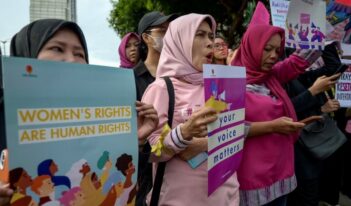
Scholars urge international legal bodies to consider eating disorders in food insecure populations.
Approximately 47 million people in the United States face food insecurity, or the “limited or uncertain ability to acquire acceptable foods in socially acceptable ways.” Globally, the United Nations (U.N.) estimates that 2.4 billion people faced food insecurity in 2022. The numbers are on the rise.
So, too, are diagnoses of eating disorders. Over 70 million people worldwide suffer from eating disorders, according to the World Health Organization.
A prominent 2017 study found that adolescents living in food insecure households were more likely to suffer from eating disorders than people in food secure households. But researchers have only begun to study the association between food insecurity and eating disorders.
In a recent article, Mariagrazia Alabrese, Giulia Bosi, and Claudia Schettini of Italy’s Sant’Anna School of Advanced Studies argue that food security regulation and monitoring systems for international human rights must consider the link between eating disorders and food insecurity.
Given that the American Psychiatric Association defines eating disorders as “a persistent disturbance of eating or eating-related behaviour that results in the altered consumption or absorption of food and that significantly impairs physical health or psychosocial functioning,” Alabrese, Bosi, and Schettini argue that food restriction affects mental health and can activate eating disorders.
Alabrese, Bosi, and Schettini emphasize that support for people struggling with eating disorders—including education about meal planning and nutrition—can be provided by specialized agencies, including the Food and Agriculture Organization of the U.N., to satisfy the four dimensions of food security.
The four dimensions of food security are food availability, access, stability, and utilization. Each of the four dimensions can impact eating disorders, Alabrese, Bosi, and Schettini explain.
Under the four dimensions in the authors’ framework, utilization—for example—can only be achieved when people actually consume the food they need. Mere access to food after periods of inconsistent availability may not end food insecurity for people who are unaccustomed to regular access to healthy food and struggle with an eating disorder, Alabrese, Bosi, and Schettini note.
To examine the regulatory response to eating disorders among food insecure populations, Alabrese, Bosi, and Schettini adopt a human rights perspective and refer to the right to food and the right to health.
Human rights monitoring systems influence how countries act to combat issues, including the prevention and treatment of eating disorders among food insecure populations, they contend. The authors found, however, that very few U.N. or international treaty bodies have addressed eating disorders among food insecure populations in non-Western regions.
The Food and Agriculture Organization of the U.N., for instance, hosted the first and second International Conference on Nutrition in 1992 and 2014. Although the conferences paid “great attention to the several social and health issues caused by undernutrition,” the authors note that neither conference referenced abnormal or disturbed eating habits following periods of food insecurity, which can lead to eating disorders.
When international bodies have addressed the prevention of eating disorders in the past, the focus from international committees and commissions has been limited to populations of young, white people in Western countries, they explain.
The authors give several examples of international bodies’ reports and comments to address eating disorders that fail to consider food insecure populations.
Alabrese, Bosi, and Schettini contend that all of these reports and comments focus on the right to health or consequences of other human rights violations, rather than the right to food, which is threatened by food insecurity.
First, the Committee on the Elimination of Discrimination against Women primarily focuses on Western media’s focus on an idealized body shape for women, Alabrese, Bosi, and Schettini explain, including the Committee’s call that Finland implement gender-sensitive counseling for women suffering from eating disorders.
Second, in the U.N. Commission on Human Rights report about violence against women, the Special Rapporteur included that “eating disorders due to unhealthy food habits [and cultural demands for thinness that have] raised a great deal of concern in the Western world.”
Finally, the U.N. Committee on the Rights of the Child’s General Comment No. 25 included eating disorders as a self-harming behavior among children and adolescents that “digitally facilitated violence” can promote, Alabrese, Bosi, and Schettini add.
To reduce the occurrence of this behavior, the Committee on the Rights of the Child recommended increasing the number of specialists in the mental health field and creating appropriate facilities for research and treatment, rather than enacting policies to address food insecurity.
The authors argue that—despite international bodies’ ability to compel countries to improve food security regulation—international bodies fail to recognize eating disorders as mental health disorders that also affect food insecure populations in nations that do not center the culture around whiteness and Eurocentric standards of thinness.
Alabrese, Bosi, and Schettini emphasize that food security includes a fundamental right to a healthy life that people suffering from eating disorders cannot enjoy. An integrative policy approach—with greater inclusivity and understanding of the mental health challenges common to communities that face food insecurity—is necessary, they contend.
The relevant U.N. human rights monitoring systems should take greater consideration of recent research about the link between eating disorders and food insecurity, Alabrese, Bosi, and Schettini conclude. Although U.N. committees and commissions are correct to consider thin, wealthy, Western women in regulatory solutions to prevent eating disorders, they argue that the mental health and wellness of all people from food insecure communities must be considered.



